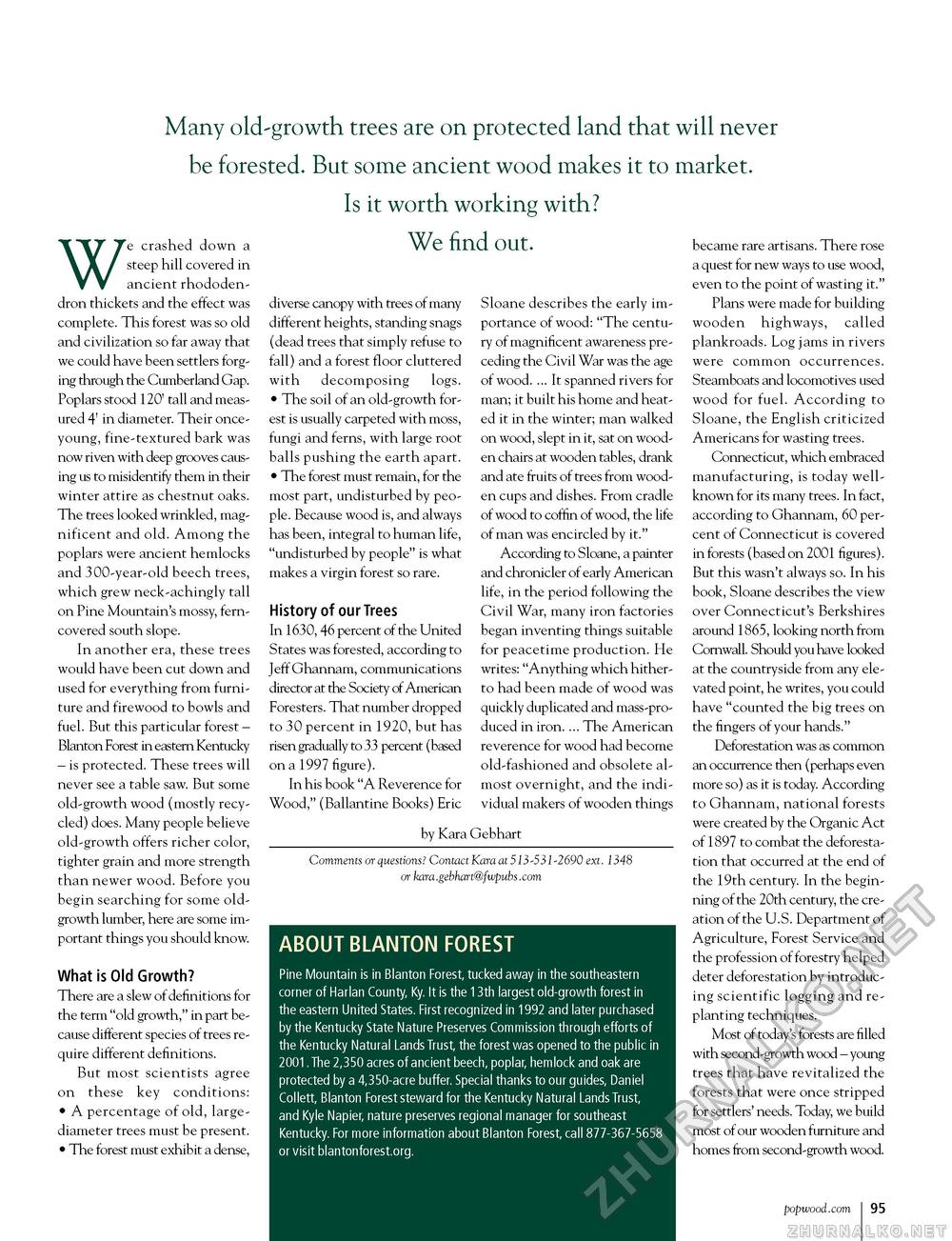Popular Woodworking 2003-12 № 138, страница 94
Many old-growth trees are on protected land that will never be forested. But some ancient wood makes it to market. Is it worth working with? We find out. We crashed down a steep hill covered in ancient rhododendron thickets and the effect was complete. This forest was so old and civilization so far away that we could have been settlers forging through the Cumberland Gap. Poplars stood 120' tall and measured 4' in diameter. Their once-young, fine-textured bark was now riven with deep grooves causing us to misidentify them in their winter attire as chestnut oaks. The trees looked wrinkled, magnificent and old. Among the poplars were ancient hemlocks and 300-year-old beech trees, which grew neck-achingly tall on Pine Mountain's mossy, fern-covered south slope. In another era, these trees would have been cut down and used for everything from furniture and firewood to bowls and fuel. But this particular forest -Blanton Forest in eastern Kentucky - is protected. These trees will never see a table saw. But some old-growth wood (mostly recycled) does. Many people believe old-growth offers richer color, tighter grain and more strength than newer wood. Before you begin searching for some old-growth lumber, here are some important things you should know. What is Old Growth? There are a slew of definitions for the term "old growth," in part because different species of trees require different definitions. But most scientists agree on these key conditions: • A percentage of old, large-diameter trees must be present. • The forest must exhibit a dense, diverse canopy with trees of many different heights, standing snags (dead trees that simply refuse to fall) and a forest floor cluttered with decomposing logs. • The soil of an old-growth forest is usually carpeted with moss, fungi and ferns, with large root balls pushing the earth apart. • The forest must remain, for the most part, undisturbed by people. Because wood is, and always has been, integral to human life, "undisturbed by people" is what makes a virgin forest so rare. History of our Trees In 1630, 46 percent of the United States was forested, according to Jeff Ghannam, communications director at the Society of American Foresters. That number dropped to 30 percent in 1920, but has risen gradually to 33 percent (based on a 1997 figure). In his book "A Reverence for Wood," (Ballantine Books) Eric Sloane describes the early importance of wood: "The century of magnificent awareness preceding the Civil War was the age of wood. ... It spanned rivers for man; it built his home and heated it in the winter; man walked on wood, slept in it, sat on wooden chairs at wooden tables, drank and ate fruits of trees from wooden cups and dishes. From cradle of wood to coffin of wood, the life of man was encircled by it." According to Sloane, a painter and chronicler of early American life, in the period following the Civil War, many iron factories began inventing things suitable for peacetime production. He writes: "Anything which hitherto had been made of wood was quickly duplicated and mass-produced in iron. ... The American reverence for wood had become old-fashioned and obsolete almost overnight, and the individual makers of wooden things became rare artisans. There rose a quest for new ways to use wood, even to the point of wasting it." Plans were made for building wooden highways, called plankroads. Log jams in rivers were common occurrences. Steamboats and locomotives used wood for fuel. According to Sloane, the English criticized Americans for wasting trees. Connecticut, which embraced manufacturing, is today well-known for its many trees. In fact, according to Ghannam, 60 percent of Connecticut is covered in forests (based on 2001 figures). But this wasn't always so. In his book, Sloane describes the view over Connecticut's Berkshires around 1865, looking north from Cornwall. Should you have looked at the countryside from any elevated point, he writes, you could have "counted the big trees on the fingers of your hands." Deforestation was as common an occurrence then (perhaps even more so) as it is today. According to Ghannam, national forests were created by the Organic Act of 1897 to combat the deforestation that occurred at the end of the 19th century. In the beginning of the 20th century, the creation of the U.S. Department of Agriculture, Forest Service and the profession of forestry helped deter deforestation by introducing scientific logging and replanting techniques. Most of today's forests are filled with second-growth wood - young trees that have revitalized the forests that were once stripped for settlers' needs. Today, we build most of our wooden furniture and homes from second-growth wood. by Kara Gebhart Comments or questions? Contact Kara at 513-531-2690 ext. 1348 or kara.gebhart@fwpubs.com ABOUT BLANTON FOREST Pine Mountain is in Blanton Forest, tucked away in the southeastern corner of Harlan County, Ky. It is the 13th largest old-growth forest in the eastern United States. First recognized in 1992 and later purchased by the Kentucky State Nature Preserves Commission through efforts of the Kentucky Natural Lands Trust, the forest was opened to the public in 2001.The 2,350 acres of ancient beech, poplar, hemlock and oak are protected by a 4,350-acre buffer. Special thanks to our guides, Daniel Collett, Blanton Forest steward for the Kentucky Natural Lands Trust, and Kyle Napier, nature preserves regional manager for southeast Kentucky. For more information about Blanton Forest, call 877-367-5658 or visit blantonforest.org. popwood.com 109 |








